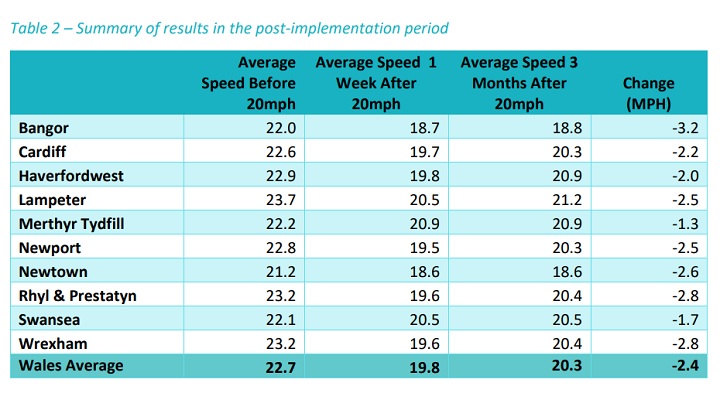
Image: Agilysis
Analysis has shown that traffic speeds on roads in Wales have fallen by 2.4mph since the introduction of the country’s default 20mph speed limit.
The report, carried out by Agilysis, analysed speeds on nearly 500km of roads in ten Welsh towns and cities. It covers the three-month period post-introduction on 17 September 2023.
The report found that average speeds are down by 2.4mph compared to pre-change levels.
It builds on previous analysis, which showed there was a 2.9mph drop in speeds in the immediate aftermath of the change.
Agilysis says the figures show that while there has been a small increase in speeds since the initial survey, compliance with the new 20mph limits is ‘generally good and shows a general acceptance of the new limit among drivers’.
The report also shows there are slight variations across the ten towns and cities included in the analysis, with Bangor experiencing the most significant reduction in average speeds (-3.2mph) and Merthyr Tydfil displaying the smallest change (-1.3mph).
Just over half (52.9%) of all analysed journeys were driven above the 20mph speed limit, while 17.9% were driven above the enforcement threshold of 26mph.
A total of 5.4% of journeys were driven at speeds above the threshold for a court summons.
The Welsh Government recently confirmed the enforcement of 20mph speed limits will begin in January, following an initial adjustment period.
Agilysis says speed enforcement measures are seen as a crucial step towards achieving greater compliance across the road network.
Let’s not confuse compliance with buy-in and mindset change. An average reduction in speed tells us no more than drivers have slowed down – it doesn’t show if there’s been an effect on collisions.
Ben Graham, Reading
+4
Problem with imposing limits, and particularly ones which (either or both) the majority of road drivers think is ridiculous and is not enforced, at least strongly enough, is that it might go some way to changing behaviour but don’t confuse that with changing mindset. Pat’s ‘multitude of sins’ would often be well covered by a change of mindset. THEN you are talking about helping people be safer on the roads because (a) they will more willingly slow down at the right places and times. So if you want a valid road safety strategy, outside schools, residential or, wherever, get to the mindset and, I am sorry, but that is not going to be achieved by hanging about with expressions such as ’85 percentile…’
Nigel+ALBRIGHT
+1
Whilst the reduction in speed is one thing the main reason for introducing the lower speed was for road safety and reduction in serious injuries, especially to pedestrians.
Are you able to provide any results as to the reduction casualties.
Stephen Hughes, Derby
+4
Talk about becoming obsessed with statistics and the automatic presumption that lowering the speed, by even 2.4mph is significant in road safety and worth having an in-depth discussion about it. This just seems symbolic of a group of people who are forever banging the road safety drum, possibly from behind a desk. If you want to talk about being safe on the roads there are better ways of going about it. I will know how safe they are when I sit alongside them on the road. You can be doing 20mph in the wrong conditions and still be dangerous.
Nigel+ALBRIGHT
+1
Comparing before and after speeds has to be done carefully and often, to take into account and remove the influence of random factors e.g. weather conditions or anything that can affect free-flowing traffic etc.
The average and the 85th%ile speeds will both tell you what you want as they are inter-linked anyway, however with respect to Pat, I’ve always found that the average speed is the better and more immediate indicator of traffic speeds.
Hugh Jones, Cheshire
--3
Average and 85th percentile speeds on individual roads are an extremely useful tool which I frequently use. However, whilst aggregating them up over a wider area can also be useful in some contexts it also covers a multitude of sins.
Pat, Wales
+5